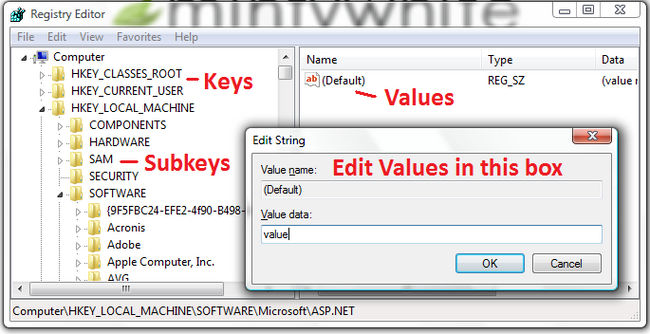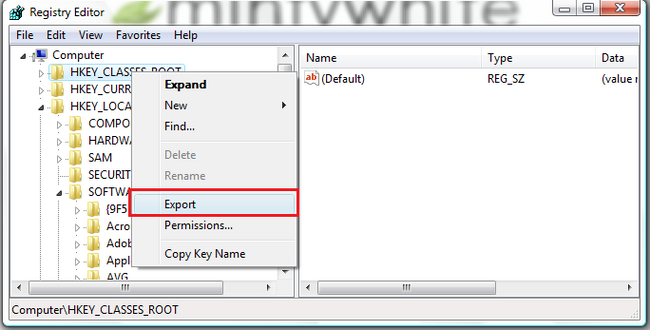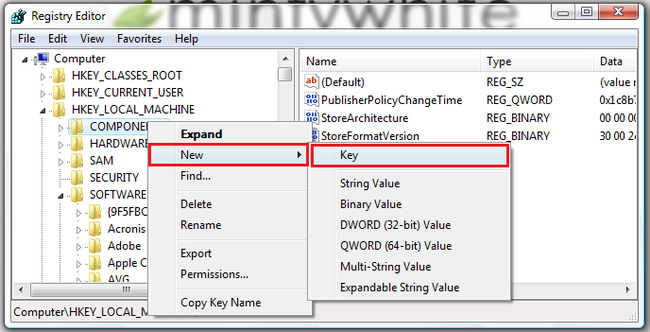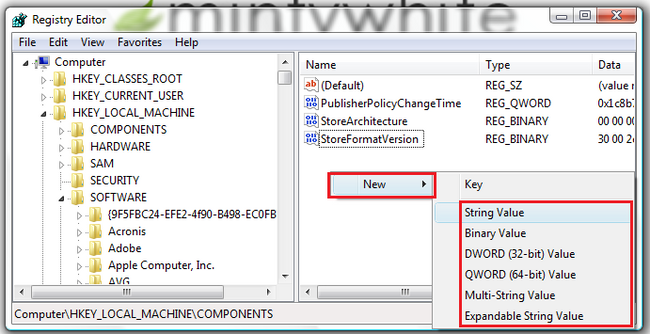 What is the Windows Registry?
What is the Windows Registry?
Think of the Windows registry as a control center for your computer. Windows settings, individual program settings, and other important configuration information are stored here.Accessing the Windows Registry Editor
In Windows 7, press the start button, type regedit, and press Enter.In Windows Vista, press the start button, type regedit, and press Enter.
In Windows XP, press Start > Run (WINKEY + R) and type regedit and press Enter.
When the registry loads you will be presented with a screen that looks like Figure 1. The registry is made up of the following components:
- Keys
- Subkeys
- Values

Figure 1: Screenshot of the Windows Registry Editor
Backing up the Windows Registry
You may back up the entire registry, or a single key you are working on. Following are instructions on performing both of these tasks in Windows 7, Vista, and XP.Backing up the entire registry
Windows 7
1. Click Start type systempropertiesprotection in the Start Search box, and then press ENTER.
If you are prompted for an administrator password or for a confirmation, type the password, or click Allow
2. Wait for Windows to search for available disks and most recent restore points. In the System Properties dialog box, on the System Protection tab, click Create
3. Type a name for the restore point and then click Create
4. After the restore point has been created successfully, click OK two times
Note: If System Restore is turned off, click to select the local disk, click Apply and then click Create.
Windows Vista
1. Click Start type systempropertiesprotection in the Start Search box, and then press ENTER.
If you are prompted for an administrator password or for a confirmation, type the password, or click Allow
2. Wait for Windows to search for available disks and most recent restore points. In the System Properties dialog box, on the System Protection tab, click Create
3. Type a name for the restore point and then click Create
4. After the restore point has been created successfully, click OK two times
Note: If System Restore is turned off, click to select the local disk, click Apply and then click Create.
Windows XP
1. Click Start, click Run, type %SystemRoot%\system32\restore\rstrui.exe, and then click OK
2. On the Welcome to System Restore page, click Create a restore point, and then click Next
3. On the Create a Restore Point page, type a name for the restore point and then click Create
4. After the restore point has been created, click Close
Note: If System Restore is turned off, you receive a message that asks whether you want to turn on System Restore now. Click Yes. Then, in the System Properties dialog box, click to clear the Turn off System Restore check box, click OK, and then repeat this step.
Backing up a Single Key
- Find the key you want to back up and right click on it
- Click Export (see Figure 2)
- Save the file somewhere safe with a distinctive name

Figure 2: Exporting a Single Key in Windows Registry Editor
Restoring the Windows Registry
You may restore the entire registry, or a single key you are working on. Following are instructions on performing both of these tasks in Windows 7, Vista, and XP.Restoring the Entire Registry
Windows 7
1. Click Start, type systempropertiesprotection in the Start Search box, and then press ENTER
If you are prompted for an administrator password or for a confirmation, type the password, or click Allow
2. In the System Properties dialog box, on the System Protection tab, click System Restore
3. In the System Restore dialog box select Choose a different restore point, and then click Next
4. Select the restore point that you want to use, and then click Next
5. Confirm your restore point, and then click Finish System restore - this restores the selected Windows 7 configuration and then restarts the computer
6. Log on to the computer. When the System Restore confirmation page appears, click OK..
Windows Vista
1. Click Start, type systempropertiesprotection in the Start Search box, and then press ENTER
If you are prompted for an administrator password or for a confirmation, type the password, or click Allow
2. In the System Properties dialog box, on the System Protection tab, click System Restore
3. In the System Restore dialog box select Choose a different restore point, and then click Next
4. Select the restore point that you want to use, and then click Next
5. Confirm your restore point, and then click Finish System restore - this restores the selected Windows Vista configuration and then restarts the computer
6. Log on to the computer. When the System Restore confirmation page appears, click OK..
Windows XP
1. Click Start, click Run, type %SystemRoot%\System32\Restore\Rstrui.exe, and then click OK
2. On the Welcome to System Restore page, click Restore my computer to an earlier time (if it is not already selected), and then click Next
3. On the Select a Restore Point page, click the system checkpoint. In the On this list select the restore point area, click an entry that is named “Guided Help (Registry Backup),” and then click Next. If a System Restore message appears that lists configuration changes that System Restore will make, click OK.
4. On the Confirm Restore Point Selection page, click Next. System Restore restores the previous Windows XP configuration and then restarts the computer.
5. Log on to the computer. When the System Restore confirmation page appears, click OK..
Restoring a Single Key
- Find the key that you previously saved
- Double click on the file and select Yes
Adding Keys or Values
In some of the tutorials on this website you will need to create a new key or value.Adding a New Key
To add a new key, do the following:- Right click on the parent key
- Select New > Key (see Figure 3)
- Follow the guide’s instructions for what key name to assign

Figure 3: Adding a New Key in the Windows Registry Editor
Adding a New Value
To add a new value do the following:- Navigate to the key that you want to add a value to
- Right click in the blank space of the right pane (see Figure 4)
- Select New > xx (Where xx is the value specified in the guide)
- Follow the guide’s instructions for what value to assign

Figure 4: Adding a New Value to a Key in the Windows Registry Editor
No comments:
Post a Comment